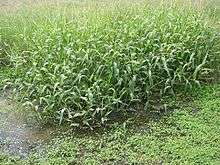Hymenachne
| marsh grasses | |
|---|---|
 | |
| Hymenachne amplexicaulis | |
| Scientific classification | |
| Kingdom: | Plantae |
| (unranked): | Angiosperms |
| (unranked): | Monocots |
| (unranked): | Commelinids |
| Order: | Poales |
| Family: | Poaceae |
| Subfamily: | Panicoideae |
| Genus: | Hymenachne P.Beauv.[1][2] |
| Synonyms[3] | |
|
Panicum sect. Hymenachnae (P.Beauv.) Hack. | |
Hymenachne is a genus of widespread wetlands plants in the grass family. They may be known commonly as marsh grasses.[4] They are distributed in tropical and subtropical regions of Asia, the Americas, and the Pacific Islands.[5] A species from the Americas, H. amplexicaulis, is well known in other parts of the world as an introduced and invasive species.[6]
Hymenachne is similar to genus Sacciolepis. Both were formerly considered part of Panicum.[7]
Hymenachne amplexicaulis
Taxonomy:
Kingdom: Plantae Division: Magnoliophyta Class: Liliopsida Order: Cyperales Family: Poaceae Genus: Hymenachne P. Beauv Species: Hymenachne amplexicaulis (Rudge) nees
Reproduction:
reproduces from seeds and broken stem fragments has a large number of viable seeds (98% viability of seed) seeds are transported in the water during annual flooding it is thought that waterbirds spread the spreads in droppings or seeds that stick to their feathers
Role in Ecosystem:
Provides a food source for cattle and other wildlife because it has 15.8% protein in whole plant Natural signal to migrating birds
Physical Characteristics:
“a tall (up to 2.5m) perennial aquatic grass that occurs in tropical America and the West Indies” “a robust, rhizomatous perennial grass” 1 to 2.5 m tall the inside of the stems are white long leaves 100-450mm 30mm wide leaves
Ecosystem Description:
Tropical America and the West Indies Grows on land or on water Was brought into Florida about 30 years ago Lakes vary in size Lakes are fed by water draining into them Lakes eventually ‘disappear’
Obtaining Food:
C3 photosynthesis- does best in late Spring/ early Summer
Adaptations:
Plants have adapted so that seeds are transported in the water during annual flooding (well adapted to flooding conditions) Large leaves- better for photosynthesis Can grow on land and water Can retain moisture for extended periods of time
Hymenachne aquatic plants frequently found in marshes and other wet habitats. Their stems are spongy with aerenchyma tissue.[7] The longest stems can reach 4 meters. They are perennial, sometimes with rhizomes. The leaves are linear or lance-shaped.[8] The inflorescence is usually a cylindrical, spike-shaped panicle, rarely with branches.[7]
Diversity
- Hymenachne amplexicaulis – West Indian marsh grass, olive hymenachne - West Indies; Latin America from Mexico to Uruguay; naturalized in Australia, parts of Asia, Florida
- Hymenachne assamica - China, Assam, Myanmar, Thailand
- Hymenachne donacifolia - Cuba, Puerto Rico, Trinidad; Latin America from Honduras to Paraguay
- Hymenachne grumosa - Paraguay, Uruguay, Brazil, Argentina
- Hymenachne patens - China (Anhui, Fujian, Jiangxi)
- Hymenachne pernambucense - Paraguay, Uruguay, Brazil, Argentina
- Hymenachne wombaliensis - Zaïre
- formerly included[9]
see Panicum Pennisetum Sacciolepis
- Hymenachne aurita - Panicum auritum
- Hymenachne boiviniana - Panicum boivinianum
- Hymenachne campestris - Sacciolepis vilvoides
- Hymenachne condensata - Panicum condensatum
- Hymenachne fluviatilis - Sacciolepis vilvoides
- Hymenachne frondescens - Panicum stoloniferum
- Hymenachne indica - Sacciolepis indica
- Hymenachne insulicola - Panicum auritum
- Hymenachne interrupta - Sacciolepis interrupta
- Hymenachne leptostachya - Panicum pulchellum
- Hymenachne montana - Pennisetum montanum
- Hymenachne myosuroides - Sacciolepis myosuroides
- Hymenachne myosurus - Sacciolepis myuros
- Hymenachne myuros - Sacciolepis myuros
- Hymenachne phalarioides - Sacciolepis indica
- Hymenachne phleiformis - Sacciolepis myuros
- Hymenachne polymorpha - Panicum auritum
- Hymenachne striata - Sacciolepis striata
References
- ↑ Palisot de Beauvois, Ambroise Marie François Joseph. 1812. Essai d'une Nouvelle Agrostographie pages 48-49 in Latin
- ↑ Palisot de Beauvois, Ambroise Marie François Joseph. 1812. Essai d'une Nouvelle Agrostographie plate X (10), figure VIII (8 a-h) at upper right; line drawings of Hymenachne sp.; figure captions on caption page 8
- ↑ Tropicos, Hymenachne P. Beauv.
- ↑ Hymenachne. Integrated Taxonomic Information System (ITIS).
- ↑ Clarkson, J. R., et al. (2011). A report of hybridisation in Hymenachne (Poaceae, Panicoideae) with description of Hymenachne × calamitosa, a new species of hybrid origin from tropical Australia. Telopea 13(1-2), 105-14.
- ↑ Hymenachne amplexicaulis. Germplasm Resources Information Network (GRIN).
- 1 2 3 Hymenachne. Flora of China.
- ↑ Hymenachne. Grassbase - The World Online Grass Flora.
- 1 2 Kew World Checklist of Selected Plant Families
- ↑ GRIN Species Records of Hymenachne. Germplasm Resources Information Network (GRIN)